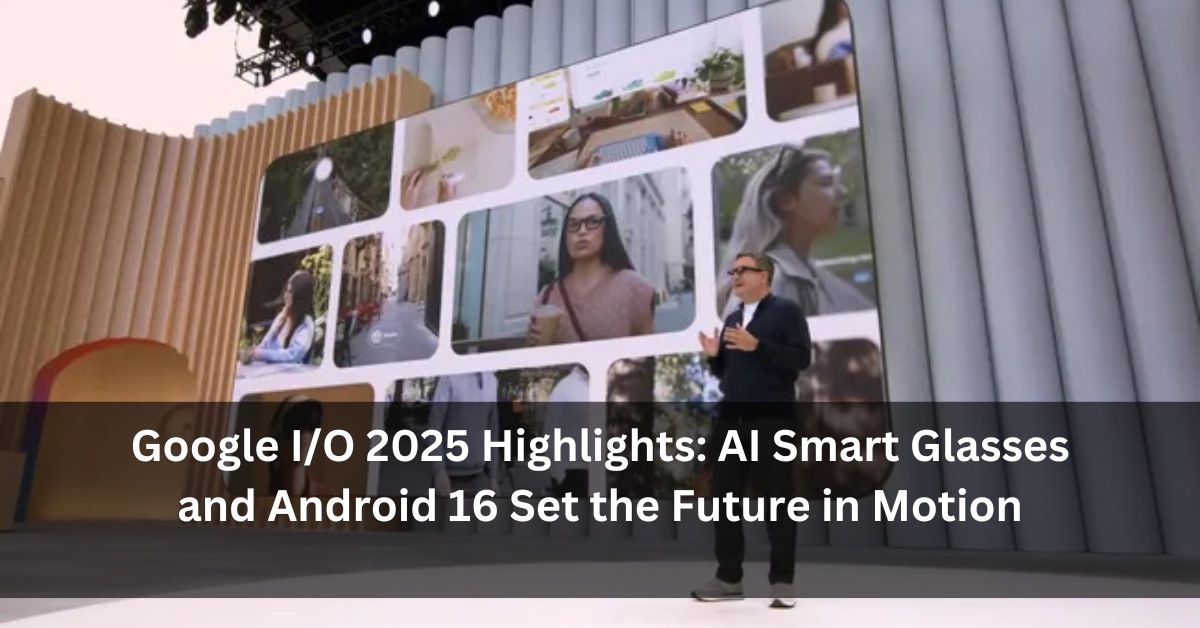Google I/O 2025 Highlights: AI Smart Glasses and Android 16 Set the Future in Motion
Google I/O 2025 has just wrapped up, and this year’s event brought some of the most exciting announcements in recent memory. From smart wearables to deep AI integration in everyday devices, Google’s focus is clear: to bring technology closer to real-life needs.
For Indian tech users and mobile enthusiasts, the key takeaways were the official unveiling of Google’s AI-powered smart glasses and the new Android 16 operating system. Here’s a full breakdown of these innovations and how they’re going to impact daily tech usage in India and around the world.
Stay updated with everything latest in mobile and AI through FutureAI, your go-to place for gadget and innovation news.
Smart Glasses: A New Kind of Wearable Technology
One of the biggest highlights from Google I/O 2025 was the introduction of its next-generation AI smart glasses. These glasses are part of Google’s Android XR (Extended Reality) initiative and have been developed with the help of popular eyewear brands such as Warby Parker and Gentle Monster.
Unlike the earlier versions that felt like experimental gadgets, this new model is designed for regular use. The glasses feature:
- Real-time language translation: Speak with anyone, no matter the language.
- Instant navigation support: Directions displayed right in front of your eyes.
- Hands-free information access: From weather updates to to-do lists, without pulling out your phone.
These smart glasses are powered by Google’s Gemini AI, which has been built to work intuitively, learning from your habits and location to offer timely assistance.
Why does this matter to Indian users? With India being a multilingual nation, the translation feature alone can be a game changer for travellers, professionals, and students. Imagine visiting Chennai from Delhi and understanding everything in Tamil through real-time translation—this is the kind of ease Google is aiming for.
For more such updates tailored to Indian users, don’t forget to visit FutureAI.
Android 16: What’s New and Why It Matters
The second big announcement at the event was Android 16. Every year, a new Android version brings improvements, but this time, the changes are more personalized and smarter.
Here are the main features introduced in Android 16:
1. Refreshed Look with Material 3 Design
Google has brought in more expressive and adaptable design tools with Material 3. This means your phone’s look and feel can now be fully customized to your mood or need. For Indian users who love colourful, aesthetic themes, this offers a more personal mobile experience.
2. Live Updates on Lock Screen
Whether it’s your Zomato order, Ola ride, or upcoming Metro station, Android 16 now gives you live updates directly on your lock screen. No need to unlock your phone repeatedly to check basic info.
This update can be especially useful in cities like Mumbai, Delhi, and Bengaluru where quick access to real-time updates is part of daily life.
3. Enhanced AI Integration
Android 16 works even more closely with Gemini AI. So tasks like composing an email, replying to WhatsApp messages, or even managing reminders are smoother and quicker.
4. Security and Privacy Upgrades
With the rise in cybercrime, Android 16 focuses heavily on giving users more control over their data. Permissions are more transparent, and location sharing now shows exactly which app is tracking you and why.
You can learn how to best use these features with regular updates from FutureAI, where we decode every new mobile tech announcement in simple words.
Smart Glasses + Android 16 = A Connected Future
The real power of these announcements lies in how they work together. When used with a phone running Android 16, the new AI smart glasses become an extension of your device. You can reply to texts, check maps, or even get cooking tips—all through voice commands and visuals directly in your eyeline.
This is especially useful for multitasking. Whether you are riding a bike, cooking, or working with your hands, the smart glasses act like a digital assistant that doesn’t interrupt your work.
For tech-savvy Indian users and young professionals, this combination could make daily life more efficient and productive.
Follow FutureAI to keep track of how Android XR and smart wearables are evolving with Indian consumer needs in mind.
What’s Next for Indian Consumers?
Google hasn’t confirmed a launch date for the smart glasses yet, but based on past patterns, a developer version may roll out later in 2025, followed by consumer versions in early 2026. Android 16, on the other hand, is expected to begin rolling out to Pixel devices by August and reach brands like Samsung, OnePlus, and Xiaomi by the year-end.
For Indian consumers, affordability will play a major role. Google’s partnership with OEMs (original equipment manufacturers) may help make both Android 16 and compatible devices accessible to a wider audience across Tier 1 and Tier 2 cities.
FutureAI will keep you informed on local availability, expected prices, and user reviews, so stay tuned if you’re planning a gadget upgrade soon.
Final Thoughts
Google I/O 2025 gave us a clear direction of where personal tech is headed: toward smarter, more natural, and assistive experiences. The new AI-powered smart glasses and Android 16 updates are more than just upgrades—they are tools that can improve everyday life.
In a country like India, where mobile devices are central to work, study, and entertainment, these innovations are timely and potentially transformative.
Stay ahead of the curve and always be the first to know what’s next in tech at FutureAI.







